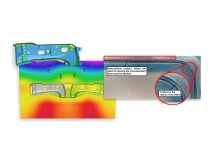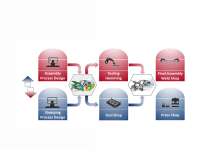Numerical controlled (N/C) cushions have previously been the realm of large OEMs and Tier 0.5 stampers in their newer large presses. Until now, the technology has been out of reach for many Tier 1 and supply chain stampers. In the meantime, stampers have survived using individual nitrogen gas springs, linked or piped gas springs, or manifold systems. In-die pressure systems, which are built into the individual tools, increase the cost of each and every die. But if the press could supply the pressure system and allow for precise control of the tooling pressures, those costs could be avoided, contributing to a more repeatable manufacturing environment.

One potential challenge with N/C cushions is their most often-mentioned perk—they are infinitely adjustable or infinitely variable. It is true that, with N/C cushions, we are able to control the forming pressure—selectively feeding material into a drawing operation at times, while restricting the material flow at others. When you have an infinite number of combinations to pick from, where do you start and when do you stop?
In the illustration above, Hyson Metal Forming Solutions, proposed the use of Servo Cushion technology as a way to optimize the forming of the component pictured by varying the binder pressure throughout the forming-the part had previously been formed in a 3-hit draw reduction process.
In the alternative process, binder tonnage was adjusted between 50-80kN (around 5 to 9 tons-force) at different points through the stroke. Through trial and error, Hyson identified a pressure profile which allowed for complete forming in one hit. Later, as a proof of concept, the trial and error approach was replaced with AutoForm-Sigma, which automated the setting and evaluated each different setting.

The Systematic Process Improvement run (AutoForm-SigmaplusR6) resolved a tonnage profile where initial high forces decreased steadily through much of the forming, held for several millimeters, and increased again near bottom, with a final release of pressure at bottom-dead-center (BDC).

A new sheet metal grade was defined as possible material for evaluation; process definition was updated and simulations started, however, the results returned a very evident and important finding. For the range of applied forces through the stroke, there was no apparent working combination. There seemed to be no possibility of identifying ANY combination of forces through the stroke that might form safely. This revelation allowed engineers to immediately inform the supplier that there is no way to make the part out of the specified advanced high strength steel material (AHSS).

But we know now, that for this specific part and tooling configuration any effort to use only cushion tonnages to resolve the forming issue did not resolve the issues. Knowing that there might be NO programmable cushion profile that works is definitely better than repeatedly running tests hoping that there MIGHT be some combination out there and believing that you have just not found it yet. The temptation to blame the toolmaker/die-setter or even the cushion manufacturer is avoided; instead the cushion positions for tonnage variation, tooling geometry, stamping process, blank shape, or other parameters must also be considered.

Without the automation provided by the engineering software, the engineers and toolmakers could have spent multiple hours, days, or perhaps weeks trying new combinations of pressures at these same positions in the stroke. By no fault of the cushion provider, or the tooling engineers, it can happen that no solution exists without adding additional forming tools or using different position profiles than the ones attempted. We know to try some other variables in the stamping process
Part data provided by Hyson Metal Forming Solutions, and results presented at the Hyson Metal Forming Symposium, September 22, 2015.














Your blogs are very informative, I am constantly referring my son to it who is very interested in sheet metal stamping. I hope to make an engineer out of him yet. Thank you for the information!
Thanks for the feedback, its great to hear that our blog appeals to younger audiences as well 🙂